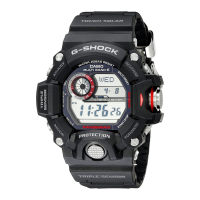
Do you have a question about the Casio RANGEMAN GW9400 and is the answer not in the manual?
| Model | GW9400 |
|---|---|
| Brand | Casio |
| Category | Watch |
| Water Resistance | 200 meters |
| Triple Sensor | Yes |
| Tough Solar | Yes |
| Radio Controlled | Yes |
| Shock Resistant | Yes |
| Display Type | Digital |
| Case Material | Resin |
| Band Material | Resin |
| Weight | 93 grams |
| Thermometer | Yes |
| World Time | Yes |
| Stopwatch | Yes |
| Countdown Timer | Yes |
| Alarm | Yes |
| Backlight | Yes |
| Mud Resistance | Yes |
| Atomic Timekeeping | Yes |
| Case Size | 55.2 x 53.5 x 18.2 mm |
| Series | G-Shock |
| Battery Life | Approx. 7 months on full charge (without further exposure to light) |
Describes the watch's sensor functions and outdoor applications.
Crucial safety warnings regarding measurement precision and product use.
Notes on watch display variations and button operation indicators.
Guides on checking battery level and identifying charging needs.
Instructs on setting Home City and DST for accurate timekeeping and data.
Details on setting the current time manually or via signal.
Provides guidance on optimal charging and warns about potential burn injuries.
Explains battery indicators, power recovery mode, and charging times.
Instructions on how to wake the watch from its sleep state.
Maps and steps to prepare for receiving time calibration signals.
Procedures for manual/auto reception, signal indicators, and precautions.
Explains how to select and switch between different watch modes.
Introduces the three primary sensor modes.
Explains automatic mode exit, initial displays, and data scrolling.
Guides on using the Timekeeping Mode for time and date management.
Notes on memory limits and accessing saved records.
Step-by-step guide to setting the Home City and daylight saving time.
Details on changing specific elements like seconds, hour, minutes, and year.
Steps to select display units for temperature, pressure, and altitude.
Guides on selecting screen format and reading interval.
Step-by-step guide to perform basic altitude readings.
How to set and use the altitude differential start point.
Steps to set a starting point for measuring altitude changes.
Steps to set a reference altitude for more accurate readings.
Explains how altitude readings are stored as records.
Details auto-tracking of high/low altitude and cumulative ascent/descent.
How altitude is measured using preset values or a reference altitude.
Important precautions for accurate and safe altimeter use.
Procedure to calibrate the compass and take direction readings.
How to align a map with the watch for navigation.
Instructions on saving and accessing bearing records.
Steps to input magnetic declination for true north indication.
Explains north definitions and factors affecting direction readings.
Procedure to take barometric pressure and temperature measurements.
Details on units and measurement ranges for pressure and temperature.
Explains how to read and interpret the barometric pressure graph.
How to read the pointer indicating relative barometric pressure changes.
Explains the meaning of different barometric pressure change indicators.
Steps to turn the barometric pressure change alert and indicator on or off.
Explains how to calibrate pressure and temperature sensors if needed.
Instructions on how to access all types of saved data records.
Warning about the irreversibility of deleting all saved data.
Warning about the irreversibility of deleting a specific record.
Steps to enter the World Time Mode and view different city times.
Steps to access Stopwatch Mode and measure elapsed time.
How to pause the stopwatch and record split times.
Steps to access Countdown Timer Mode and set the start time.
How to start and run the countdown timer and stop its alarm.
Steps to access the Alarm Mode.
Procedure to set a daily alarm time.
How to enable or disable alarms and the hourly time signal.
How to view sunrise and sunset times for the current day.
How to configure location details for accurate sunrise/sunset times.
How to manually activate the watch's backlight.
Explains auto light switch and provides critical safety warnings.
Advice on using the auto light switch to avoid battery drain and distractions.
How to turn the button operation tone on or off.
How to enable or disable the Power Saving function.
Solutions for time accuracy and calibration issues.
Explains "ERR" indicator and reading issues in sensor modes.
Addresses problems with altitude and direction reading accuracy.
Addresses problems with time settings in the World Time Mode.
Solutions for issues when the watch does not resume operation after charging.
Solutions for ERR indicators and incorrect time settings from signals.
Explains why manually set times might change due to auto-receive.
Solutions for issues preventing auto or manual signal reception.
Addresses incorrect time or day settings after signal reception.
Details on timekeeping accuracy, signals, and sensor ranges.
Specifications for stopwatch, timer, alarms, world time, and illumination.
Information on the power source and battery operating duration.
